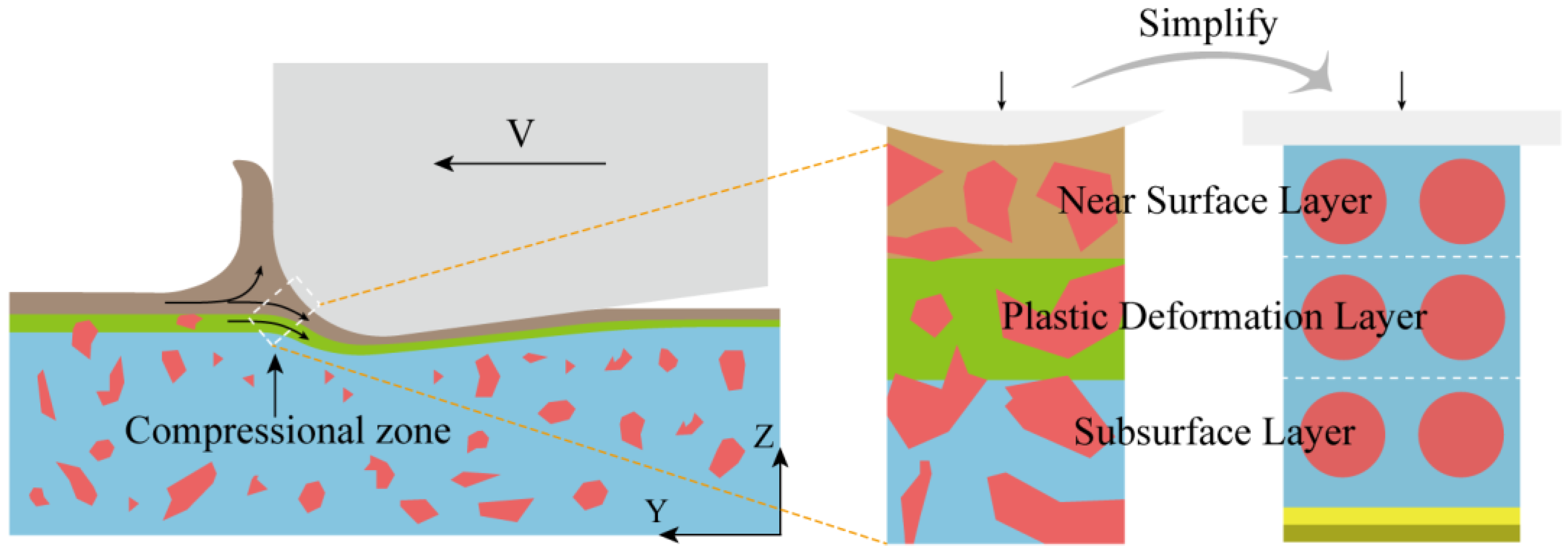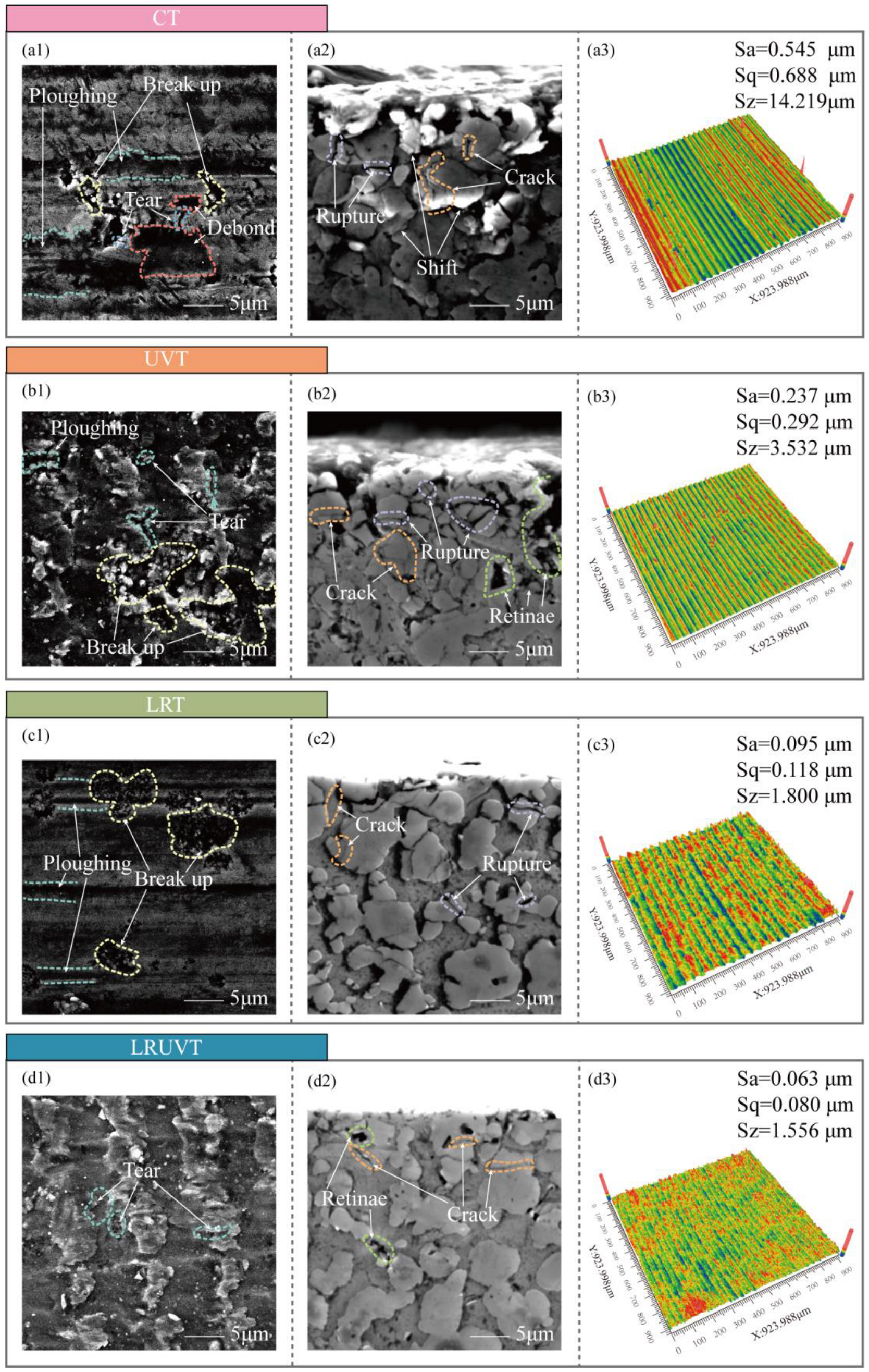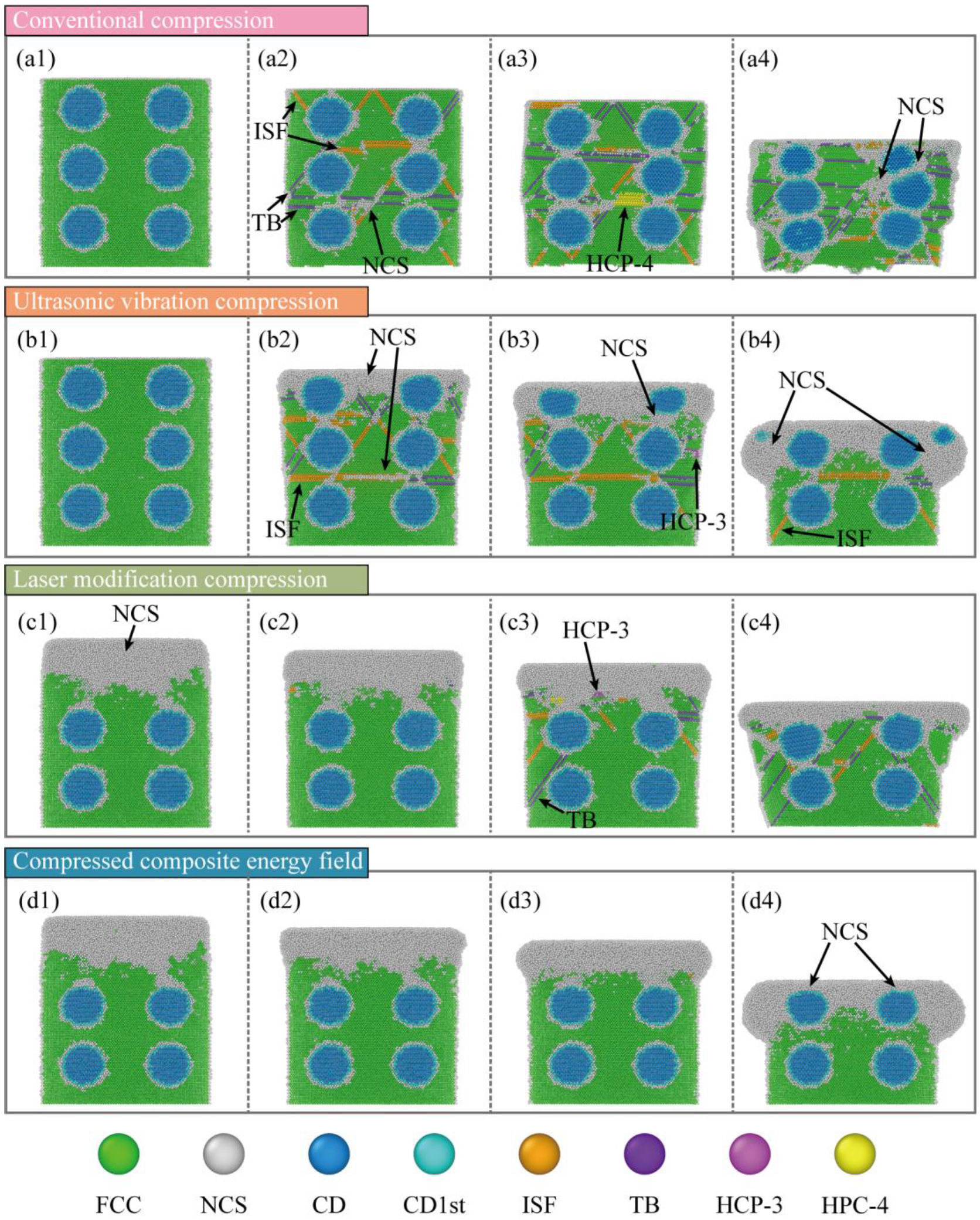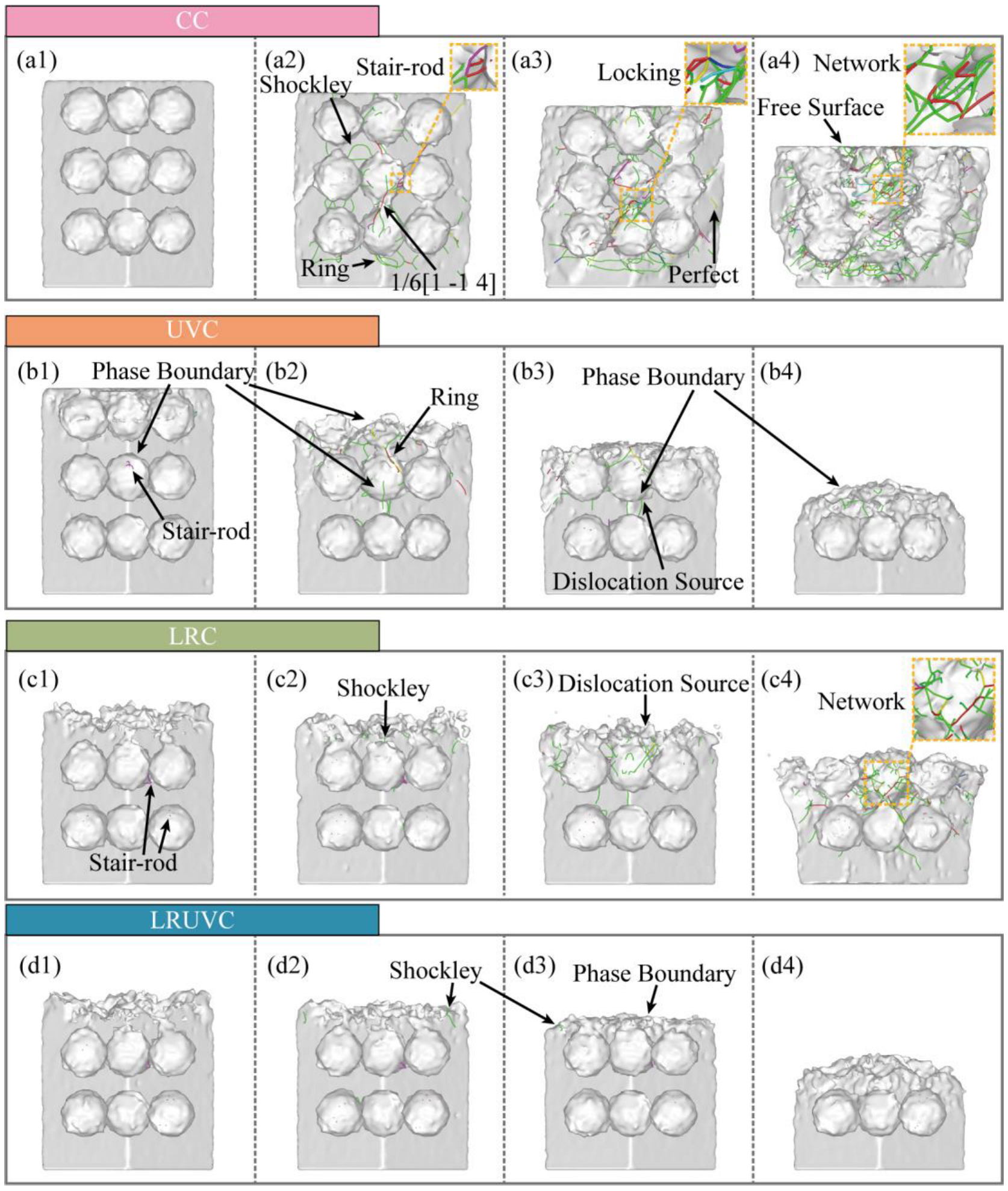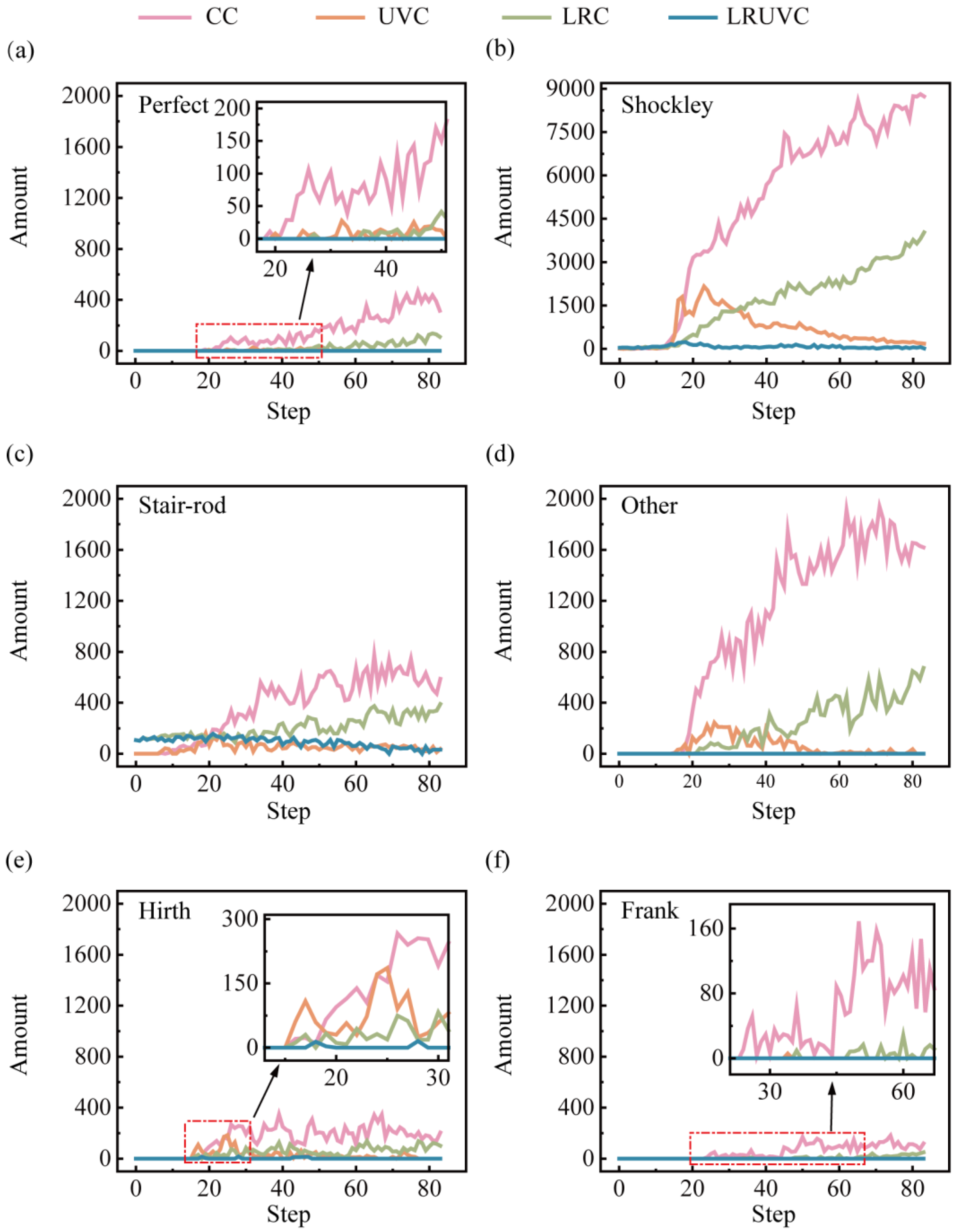3.2. Simulation Results
The overall mechanical response under each processing mode was compared through the calculated stress–strain curves presented in
Figure 5. Conventional compression (CC) exhibits the highest yield peak stress, followed by a high early-stage flow stress plateau with irregular fluctuations, consistent with continuous loading and pronounced work hardening. In ultrasonic vibration compression (UVC), the stress reaches an initial peak before rapidly decreasing to a lower, periodically oscillating level, characteristic of intermittent loading and demonstrating significant acoustic softening [
33]. Laser-remelting compression (LRC) shows substantially reduced peak and steady-state flow stresses compared to CC. The stress attenuates gradually during compression, maintaining a moderate level with limited work hardening and no distinct yield point phenomenon. Laser-remelting ultrasonic-vibration compression (LRUVC) displays the lowest initial peak stress, which then rapidly decays to the minimum sustained stress level with only minor oscillations. Collectively, both laser remelting and ultrasonic vibration effectively reduce peak and average stress, with the LRUVC mode providing the most pronounced and stable suppression of both stress magnitude and fluctuations.
Four characteristic compression depths common to all modes were identified from the stress–strain curves for detailed analysis: 6 nm (elastic stage), 20 nm (early plastic stage, termed ‘pre-compression’), 35 nm (mid-compression, ~50% of near-surface thickness), and 80 nm (end of compression, full near-surface thickness).
Figure 6 presents the evolution of hydrostatic stress, a key parameter governing volumetric changes and exerting a strong influence on defect formation and crack propagation.
Figure 6a–d represent the compression modes CC, UVC, LRC, and LRUVC, while columns (1–4) correspond to depths of 6, 20, 35, and 80 nm, respectively.
During the initial compression stage in CC (
Figure 6(a1)), the overall hydrostatic stress is low. Stress concentrations are primarily localized near silicon particles, with a notably higher magnitude at the bottom boundary, indicating a downward propagation trend that is ultimately limited by the model dimensions At the early compression stage (
Figure 6(a2)), hydrostatic stress increases with the emergence of work hardening. High compressive stress transfers to the particle extremities and the intervening Al matrix, forming continuous high-stress bands. During the middle stage (
Figure 6(a3)), the stress intensifies and becomes increasingly concentrated in the interparticle regions and at the fixed-layer interface. This progression culminates at the final compression stage (
Figure 6(a4)), where the stress is intensely localized at the contact points between clustered particles.
The initial stage of UVC (
Figure 6(b1)) exhibits the highest instantaneous hydrostatic stress among all modes, with a peak below −11 GPa. The ultrasonic excitation generates a surface high-pressure zone that propagates downward as a stress wave. This wave attenuates rapidly, resulting in a shallower affected depth than in CC despite the higher initial stress peak. In the early UVC stage (
Figure 6(b2)), the peak stress decreases, manifesting as acoustic softening through a reduction in the effective elastic modulus. Although the stress wave persists, material yielding occurs, and the diminished modulus restricts deeper penetration. By the middle stage (
Figure 6(b3)), further material softening in the top region causes the stress peak to fall below the CC level at equivalent depth. A localized high-stress zone develops near the end face and undergoes in-situ relaxation, accompanied by the near-complete dissipation of the stress wave. In the final stage (
Figure 6(b4)), a subsequent loading cycle initiates as deeper particle layers engage, producing a renewed stress increase with a diminished peak attributable to cumulative softening effects.
The mechanical response in LRC demonstrates a distinct stress distribution. The stress field remains dispersed and maintains a low magnitude with minimal increase throughout the early to middle stages (
Figure 6(c1–c3)), primarily concentrating within the remelted layer and around the bottom particles. The disordered microstructure of the remelted layer facilitates load distribution, resulting in an overall stress level comparable to the initial CC stage and confirming the stress-reduction effect of laser remelting. This behavior persists until the final compression stage (
Figure 6(c4)), when the underlying particle layer begins to influence the mechanical response, producing a hybrid LRT-CC mode. The stress magnitude progressively rises, and the concentration zone transitions toward the inter-particle aluminum matrix. With continued compression, the stress distribution converges toward the CC pattern. Consequently, effective utilization of laser remelting in practice requires precise matching of the cutting depth to the remelted-layer thickness.
The LRUVC exhibits a transitional response, evolving from a remelting-dominated to an ultrasonic-dominated state. At the initial compression stage (
Figure 6(d1)), the overall stress distribution closely resembles that of LRC (cf.
Figure 6(c1)), with concentrations within the remelted layer and bottom particles. The superimposed ultrasonic energy elevates the stress magnitude slightly above pure LRC levels, although it remains substantially lower than in UVC. During the early to middle compression stages (
Figure 6(d2,d3)), the stress magnitude experiences a moderate increase. The system undergoes a rapid transition from the initial remelting-dominated regime to a state exhibiting ultrasonic-vibration characteristics, achieving this shift more rapidly than in pure UVC. Crucially, the hybrid mode eliminates the pronounced early stress peak and deep stress wave propagation characteristic of UVC—phenomena that pose practical risks by potentially activating pre-existing defects. Instead, LRUVC maintains a moderated initial response while directly accessing the more stable mid-to-late-stage deformation behavior of UVC. By the final compression stage (
Figure 6(d4)), load-bearing transitions predominantly to the underlying unremelted layer. The resulting stress distribution pattern resembles that of UVC but exhibits a moderately reduced magnitude compared to pure UVC (cf.
Figure 6(b4)). With continued compression, the response would converge completely toward the characteristic UVC state.
In summary, CC produces deep hydrostatic stress penetration with intense sub-surface concentration and severe deformation. Ultrasonic vibration compression (UVC) localizes stress near the surface but generates excessive early-cycle peaks and potentially detrimental stress waves. Laser-remelting compression (LRC) effectively mitigates stress concentration but provides limited control over its penetration depth. The hybrid LRUVC mode achieves optimal performance, maintaining low stress peaks and uniform distribution throughout loading, thereby demonstrating superior capabilities in stress regulation and mitigation.
Von Mises stress, which characterizes distortion energy and serves as a fundamental yield criterion, is analyzed in
Figure 7. During the initial stage of conventional compression (CC,
Figure 7(a1)), prior to yielding onset, the stress field exhibits a diffuse distribution. Beyond localized concentrations surrounding Si particles, the stress is widely distributed throughout the workpiece without pronounced localization or directional propagation. As compression progresses (
Figure 7(a2)), the von Mises stress increases substantially. Silicon particles distributed along the deformation path serve as nucleation sites for stress propagation along slip systems. This behavior reflects the combined effects of load-transfer strengthening and work hardening, both contributing to the elevated von Mises stress levels. With continued compression (
Figure 7(a3)), the von Mises stress intensifies and becomes increasingly concentrated at particle contact points. This progression culminates in the final stage (
Figure 7(a4)), where the stress reaches its maximum magnitude and becomes intensely localized within interparticle contact regions.
In UVC, the von Mises stress similarly exhibits high magnitude and localized concentration. At the initial stage (
Figure 7(b1)), prior to yielding onset, the primary load is carried by the first particle layer and the adjacent aluminum matrix [
34]. A distinct stress wave emerges in the von Mises distribution, spatially coincident with the hydrostatic wave, demonstrating a coupled compression-shear transmission mechanism governed by the crystal lattice and loading path. As compression progresses (
Figure 7(b2)), the stress wave attenuates while the near-surface region supports the predominant von Mises stress. The stress magnitude increases abruptly, transitioning the material into an intense compression-shear state. In contrast to the hydrostatic stress evolution (cf.
Figure 6(b3,b4)), the von Mises stress exhibits only moderate attenuation during continued loading, indicating sustained accumulation of distortion energy through persistent high-level fluctuations rather than periodic decay.
In LRC, the initial stage (
Figure 7(c1)) exhibits a remelted layer characterized by a disordered solid solution structure instead of a regular crystal lattice. This amorphous structure inhibits the formation of localized stress concentrations, resulting in a stress field of reduced magnitude and enhanced uniformity. During the early compression stage (
Figure 7(c2)), while the stress magnitude increases, it maintains a dispersed distribution throughout the remelted layer rather than concentrating at particle-matrix interfaces. As compression progresses to greater depths (
Figure 7(c3)), the stress distribution shifts toward the interfaces between the unremelted matrix and embedded particles. While this propagation trend resembles that observed in CC, the peak stress magnitude remains substantially lower, demonstrating the remelted layer’s capacity to mitigate subsurface shear stress transmission. In the final stage (
Figure 7(c4)), load transfer occurs primarily to the underlying unremelted particle layer. Although the resulting stress pattern converges toward the CC distribution and the stress level increases correspondingly, the degree of localization remains significantly attenuated compared to conventional compression.
In LRUVC, the von Mises stress shows the synergy of remelting and ultrasonic. At the start (
Figure 7(d1)), the pattern is close to LRC. The remelted layer lowers the peak and greatly eases the transient stress wave from the ultrasonic. The stress is concentrated at the surface and the first particle layer. As depth increases, the stress rises and focuses at the top. But there is no sharp peak as in UVC. The change is smoother. It means that the remelted layer dissipates the early strong wave and prevents deep subsurface distortion. By the end (
Figure 7(d4)), the remelted layer has flowed outward and lost load-bearing capacity. So, the pattern approaches UVC. The overall peak remains slightly lower than in the pure UVC case.
Summary, in CC, von Mises stress rises with compression and concentrates at particle contacts, reflecting load transfer and work hardening. In UVC, a clear early stress wave appears with strong compression-shear coupling. Although the wave fades later, the von Mises level stays high, showing continued build-up of distortion energy. In LRC, the remelted layer weakens concentration and helps dissipate distortion energy. So, the overall level is lower and more uniform. With deeper loading, the pattern moves toward CC. In LRUVC, remelting and ultrasonic work together. The dispersion effect of the remelted layer suppresses the stress wave effect caused by vibration and reduces the peak stress, so that the stress field remains uniform. The stress concentration effect of ultrasonics prevents the stress caused by the remelting layer from being too dispersed and concentrates the stress on a more “surface” position.
The equivalent plastic strain (EPS) is computed from the deformation gradient tensor of local atomic neighbors. As a stress-driven response, it captures both elastic deformation and irreversible plastic rearrangement. Its values can span several orders of magnitude. To ensure comparison across modes and loading stages, a single colormap was used for all EPS maps. The lower limit is 0.002 to suppress background noise and small numerical fluctuations. The upper limit is 1.5. It covers the main strain ranges of the elastic stage (von Mises strain < 0.02), dislocation slip and twin initiation stage (0.05–0.3), local amorphization and severe plastic deformation stage (0.5–1.0). A small number of values above the upper limit are shown by truncation (clipped to the maximum color), which avoids compressing the overall color dynamic range.
At the initial stage of CC (
Figure 8(a1)), the strain value is at a low level, the overall distribution is dispersed, and there is no obvious concentrated area, which reflects the uniform deformation response of the material in the elastic stage. In the intermediate stage (
Figure 8(a2)), the strain rises rapidly with the increase in von Mises stress. A high-strain band is formed at the slip surface between the particle and the matrix, showing the crack initiation along the interface and slip surface. At the middle stage of compression (
Figure 8(a3)), the strain is further increased. And it is highly concentrated between the particles and near the fixed layer. The local plastic zone expands significantly. The plastic strain of the matrix is wrapped around the particles to slide together. The high strain of the interface shows the phenomenon of particle debonding. At the end of compression (
Figure 8(a4)), the strain level reaches the maximum. A wide range of high-strain areas is distributed between the particles and the central region. The workpiece has significant pier coarse deformation. The particles are significantly displaced and accumulated. The high plastic strain caused by particle accumulation easily leads to the occurrence of particle fracture. The conventional compression shows the law of uniformity in the early stage, gradual development in the middle stage, and finally comprehensive expansion. The matrix slips and wraps the accumulation of particles, and the plastic distortion is mainly regulated by the coordination of particles and matrix.
At the initial stage of UVC (
Figure 8(b1)), EPS is relatively high and is concentrated mainly at the surface of the remelted layer. The overall pattern remains fairly uniform. The disordered structure has limited long-range support. So, it is more prone to strain. In the early stage (
Figure 8(b2)), EPS rises quickly, and the affected area expands. While the high strain is still mostly confined to the top of the remelted layer. In the middle stage (
Figure 8(b3)), EPS keeps increasing, though still at a moderate level. The distribution lies mainly within the remelted layer and begins to extend downward. At the end stage (
Figure 8(b4)), EPS increases further, and the pattern gradually approaches CC. High-strain zones extend downward along slip planes, indicating a higher risk of cracking in the matrix beneath the remelted layer. Overall, loading after remelting shows a high initial level, slow accumulation, locally dispersed distribution, and delayed diffusion, reflecting the homogenizing and buffering effects of the remelted layer on plastic deformation. However, protection of the underlying region gradually fails at later stages.
At the initial stage of LRC (
Figure 8(c1)), EPS is relatively high and is concentrated mainly at the surface of the remelted layer. The overall pattern remains fairly uniform; the disordered structure has limited long-range support. So it is more prone to strain. At the early stage (
Figure 8(c2)), EPS rises quickly. And the affected area expands. The high strain is still mostly confined to the top of the remelted layer. At the middle stage (
Figure 8(c3)), EPS keeps increasing. Though it is still at a moderate level. The distribution lies mainly within the remelted layer and begins to extend downward. The end stage (
Figure 8(c4)), EPS increases further, and the pattern gradually approaches CC. High-strain zones extend downward along slip planes, indicating a higher risk of cracking in the matrix beneath the remelted layer. Overall, after loading ultrasonic, it shows the characteristics of low initial, rapid increase, local concentration, and extreme peak. The occurrence of local plastic failure is significantly accelerated, which reflects the homogenizing and buffering effects of the remelted layer on plastic deformation. However, protection of the underlying region gradually fails at later stages.
In LRUVC, EPS reflects the synergy between remelting and ultrasonic vibration. At the initial stage (
Figure 8(d1)), the strain level is high and the distribution reaches slightly deeper than in LRC. Yet, the concentration still lies near the top of the remelted layer and around the first particle layer, indicating that the remelted layer effectively weakens the near-surface concentration caused by ultrasonic impact. In the early and middle stages (
Figure 8(d2,d3)), EPS rises rapidly and the affected region expands. However, the growth rate is lower than in UVC because of the remelted layer. And the depth of the ultrasonic concentration effect is smaller than in LRC, demonstrating the complementary advantages of the hybrid field. This ability to hold a more stable strain within a smaller region combines efficiency with stability. At the end stage (
Figure 8(d4)), the overall pattern approaches UVC. The peak is slightly lower. The edge localization is milder. And the end-stage failure seen in LRC does not appear. Overall, the hybrid mode couples the strengths of both fields and controls both strain intensity and penetration depth throughout loading, highlighting the dual benefits of fast effectiveness and process stability in LRUVC.
Overall, CC shows strain concentrated along slip planes at the particle-matrix interface, indicating a plastic-deformation mode dominated by particle debonding and particle accumulation. UVC exhibits strong concentration with extreme peaks. Although it accelerates strain development and limits penetration depth, the mid-cycle response is prone to instability, leading to particle fracture and surface spalling. At the early stage of LRC, strain is higher yet more uniform, reflecting the homogenizing and buffering roles of the remelted layer in plastic flow. However, the response inevitably shifts toward CC with deeper loading. LRUVC combines the strengths of both. It suppresses the severe early ultrasonic strain concentration while keeping peaks lower and the distribution controlled. As a result, it balances fast response with stability and provides the best control over the evolution of plastic strain.
To probe the microscopic slip mechanisms during compression, the Crystal-Analysis-Tool (CAT) was used to identify and count defects.
Figure 9 shows the evolution of the defect distributions. In CC, the workpiece with only a few defects at interfaces is mainly face-centered cubic (FCC) in the early stage (
Figure 9(a1)). At the next stage (
Figure 9(a2)), stacking faults grow rapidly along slip planes and interfaces. And twins appear in high-strain zones, indicating slip activation. At the middle stage (
Figure 9(a3)), defects increase further, and local body-centered cubic (BCC) regions emerge. Multiple defect types form an interwoven network, showing entry into a severe plastic-flow regime. At the end stage (
Figure 9(a4)), defects spread across the workpiece. SFs and twins extend over large areas. And overall crystal integrity is seriously degraded.
In UVC, FCC lattice still dominates at the start (
Figure 9(b1)), which is similar to CC. At the early stage (
Figure 9(b2)), surface crystals within high-strain zones lose long-range order and transform into an amorphous state. At the same time, many stacking faults (SFs) form rapidly between particles and in the subsurface layer. And twin bands appear locally. Some twins further convert to amorphous, evidencing severe plastic flow driven by ultrasonic impact. At the middle stage (
Figure 9(b3)), amorphous regions keep expanding downward. But part of the amorphous phase reverts to SFs as the hydrostatic stress decreases. A smaller population of SFs continues to extend to deeper layers. At the end stage (
Figure 9(b4)), the top particles and matrix are severely damaged. Large areas of the crystal transform into amorphous material. It is accompanied by a smaller number of defects extending further downward.
In LRC, the surface layer is a disordered solid solution at the initial stage (
Figure 9(c1)). And it gradually transitions downward to the FCC lattice. In the early stage (
Figure 9(c2)), a small number of SFs form beneath the remelted layer. But their population remains limited. In the middle stage (
Figure 9(c3)), defects increase markedly, and the response shifts toward CC. SFs and twins initiate from the remelted layer and from interfaces. In CC and UVC, defect development extends not only along the main FCC slip system {111} (about 45°) but also activates many secondary slip systems (e.g., {100}) due to cross-slip and high hydrostatic stress. After laser remelting, this broader activation is suppressed. At the end stage (
Figure 9(c4)), defects continue to grow and interweave. The active slip-system set is narrower. Overall defect content is higher than in UVC yet lower than in CC.
In LRUVC, defect evolution reflects the coupling of the two mechanisms. Throughout loading (
Figure 9(d1–d4)), crystal integrity remains very high outside the remelted layer. The strong localization of the high-strain zone keeps structural damage confined. Lattice collapse occurs mainly within this zone. And only a small number of defects form and propagate downward. Although this ideal behavior is partly related to the single-crystal modeling simplification, it still demonstrates the clear advantage of the composite energy field in damage control. This phenomenon was also verified in the wear resistance experiment of Fu et al. [
35].
To clarify defect evolution with increasing compression, Python (3.11.5) was used to extract counts of the relevant defect types and diamond structures. And plotted the results in
Figure 10. In
Figure 10(a1), the fraction of FCC decreases rapidly at the early stage of compression. The CC and UVC have the fastest drop. By contrast, the remelted layer preferentially bears the load in LRC and LRUVC. So, FCC weakening is more moderate. In
Figure 10(a2), intrinsic stacking fault (ISF) counts rise quickly in CC and UVC. Then it declines after reaching a peak, indicating that part of the ISF population transforms into an amorphous phase.
Figure 10(a3) shows that the twin boundary (TB) increases markedly and then decays in UVC. It is a trend consistent with the ISF-to-amorphous transition. In CC, however, TB continues to grow after an early rapid rise, indicating delayed weakening. The behavior also appears in LRC. Though it is milder.
Figure 10(a4) indicates that HCP accumulates gradually in CC and LRC. While it appears mainly at the mid-stage in UVC. It signals the highly unstable plastic state there. Across these three defect types (ISF, TB, HCP), LRUVC shows very low levels, underscoring the strong defect-control capability of the composite energy field.
Figure 10(b1,b2) presents the evolution of the perfect cubic diamond structure and the first-nearest-neighbor cubic diamond structure. During compression, the perfect diamond count decreases rapidly under UVC, indicating damage to particle integrity. At the late stage of CC, the rate of change of the perfect diamond metric points to a non-negligible level of particle damage. Interestingly, the first-nearest-neighbor diamond metric in CC shows a rebound at later stages, suggesting that under high stress, the diamond framework undergoes not only brittle fracture but also local slip with the formation of stacking faults or twins. The behavior was also reported in Nie [
36].
Overall, defects nucleate quickly and spread widely in CC. Stacking faults and twins form in large numbers. And crystal integrity is severely degraded. UVC drives strong early structural evolution, rapidly producing amorphous regions and stacking faults. Twin bands propagating downward. Although it accelerates plastic flow, it also causes severe structural damage. LRC effectively suppresses early defect formation and limits slip-system activation, showing the delay and buffering effects of the remelted layer. However, the response gradually shifts toward CC with deeper compression. LRUVC offers the best defect control. Overall, crystal integrity remains high. And only limited defects evolve. The defects are confined to local high-strain zones. Counts of stacking faults, twins, and amorphous regions are much lower than in the other modes, highlighting the advantage of the composite energy field in damage suppression and structural-integrity maintenance.
Dislocation-evolution snapshots obtained with the Dislocation Extraction Algorithm (DXA) of the different compression modes are shown in
Figure 11. The spatial patterns of dislocations are broadly consistent with the defect maps. To clarify how defects develop with compression, it was extracted that the total dislocation length by type was extracted and plotted in
Figure 12.
In Al alloys with high stacking-fault energy (SFE), plasticity relies mainly on perfect dislocations and their decomposition products. Perfect dislocations are commonly activated by Frank-Read sources. And the dislocations also nucleate at stress concentrators such as interfaces, holes, particle sharp corners, or grain boundaries. They carry most of the slip and load transfer, and their continuous build-up causes work hardening. Under strong shear or interface constraints, a perfect dislocation can split into two Shockley partials, producing stacking faults. Shockley partials nucleate and migrate more easily at interfaces, near the free surface, and in stress-concentration zones, often signaling stacking-fault-mediated slip and even twin initiation. When two symmetric Shockley partials meet on a cross-slip plane, stair-rod dislocations can form. These dislocations are essentially immobile, acting as locks that pin the network and further strengthen hardening. Hirth dislocations arise mainly from dislocation interactions, move poorly, hinder glide, and add to hardening. Frank dislocations, linked to stacking-fault loops, are also immobile. They reshape the local stress field and obstruct passing dislocations. In our study. Their length is generally low, indicating that slip dominates the compression process. The other category (strongly curved segments, short-lived reaction segments, or mixed-character lines) tracks the rapid rearrangement of the network. The increase in this class usually accompanies surface disordering, frequent slips, and local damage.
In this study, all three modes except LRUVC are driven by strong shear strain, which activates many dislocations from the free surface and the Al-Si phase boundary and sends them along the {111} slip-plane family to the next interface. In the FCC system, Shockley partials carry most of the slip. As Shockley lines meet and react during propagation, they generate additional stair-rod dislocations, producing marked local interlocking. The overall fraction of perfect dislocations is low. It is consistent with aluminum’s stacking-fault behavior. Most perfect segments rapidly decompose into Shockley partials, leaving only short remnants at the heads and tails of slip bands. Frank and Hirth dislocations are rare, indicating that climb and stick-slip are largely suppressed under compression. Note that the other class (e.g., entries like in
Figure 11(a2) 1/6 [1-14]) mainly reflects high-strain-induced crystal rotation and lattice distortion, which prevent DXA in OVITO from fully resolving the standard cubic frame. When the Burgers vector is rotated back to the cubic basis, many of these segments reassign to stair-rod or Shockley types.
In CC, counts for nearly all dislocation types are highest. The rapid proliferation of dislocations builds a dense network, raising local stress via work hardening. Once interlocking and pinning are overcome, the lengths of different types surge together with strong fluctuations, making this mode the least stable. In UVC, early dislocation nucleation increases. But cyclic loading promotes cross-slip, recovery, and annihilation, which reduce the net build-up of perfect and Shockley segments and shorten the lifetime of stair-rod locks. Consequently, Shockley and stair-rod lengths show a first-increase-then-decrease trend from the mid stage onward. In LRC, stress redistribution by the remelted layer lowers the migration barrier, delaying interlocking in stages. As compression deepens and the remelted layer weakens, its redistribution ability declines, and the accumulation pattern drifts toward CC. A noticeable early population of stair-rod segments in LRC and LRUVC suggests that thermal stress from remelting in the unmelted zone can induce corresponding reaction dislocations.
In LRUVC, nucleation is suppressed at the source, intersections are reduced, and annihilation is accelerated by the synergy between stress redistribution (Generated by the remelted layer) and stress concentration (Generated by ultrasonic vibration). The remelted layer reduces the local effective SFE and the migration barrier, homogenizes stress, and extends the average free path of dislocations. The high-frequency alternating shear of ultrasonics promotes alternating slip and recovery, continuously removing short-range Shockley segments. Remelting-induced stair-rod locks do not readily re-accumulate or persist. With a more uniform force field, local stress peaks and GND density are suppressed, the extension of stacking-fault/twin bands is limited, and the material maintains very low dislocation density, small fluctuations, and a highly stable plastic response throughout loading. Overall, LRUVC avoids the disordered proliferation and network hardening seen in CC. It more effectively suppresses re-accumulation and interlocking than UVC, and achieves stable, process-wide control.
